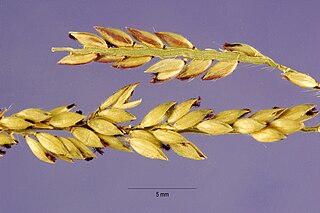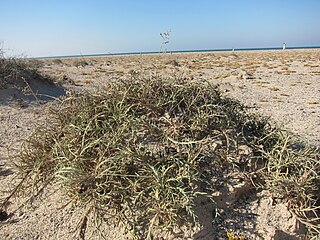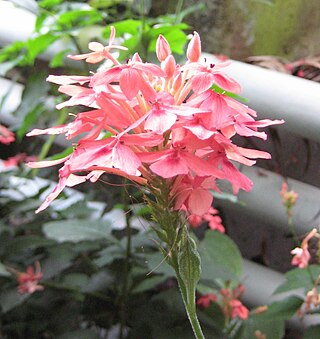
The Bushveld is a sub-tropical woodland ecoregion of Southern Africa. The ecoregion straddles the Tropic of Capricorn and constitutes the southern part of the Zambezian region. It encompasses most of Limpopo and a small part of North West in South Africa, the Central and North-East Districts of Botswana and the Matabeleland South and part of Matabeleland North provinces of Zimbabwe. The Kruger National Park has a number of 'Bushveld' camps, but these are strictly speaking in the lowveld, as these terms are sometimes used interchangeably. Although their limits are somewhat blurred, lowveld is generally restricted to the more easterly parts of South Africa and Zimbabwe.

Pennisetum is a widespread genus of plants in the grass family, native to tropical and warm temperate regions of the world. They are known commonly as fountaingrasses. Pennisetum is considered a synonym of Cenchrus in Kew's Plants of the World Online.

Adenium obesum, more commonly known as a desert rose, is a poisonous species of flowering plant belonging to the tribe Nerieae of the subfamily Apocynoideae of the dogbane family, Apocynaceae. It is native to the Sahel regions south of the Sahara, tropical and subtropical eastern and southern Africa, as well as the Arabian Peninsula. Other names for the flower include Sabi star, kudu, mock azalea, and impala lily. Adenium obesum is a popular houseplant and bonsai in temperate regions.

Melhania is a genus of small shrubs or herbaceous plants. Traditionally included in the family Sterculiaceae, it is included in the expanded Malvaceae in the APG and most subsequent systematics. The genus is named for Mount Melhan in Yemen.

Eriochloa is a widespread genus of plants in the grass family, commonly called cupgrass. They are found across much of Africa, Asia, Australia, and the Americas, plus a few places in European Russia.

Eublemma is a genus of moths of the family Erebidae described by Jacob Hübner in 1829.

Anthephora is a genus of plants in the grass family, native to southwest Asia, Africa, the Americas, and various islands.

Urochloa, commonly known as signalgrass, is a genus of plants in the grass family, native to tropical and subtropical regions of Eurasia, Africa, Australia, the Americas, and various islands.

Odyssea is a genus of African and Arabian plants in the grass family.

Capparis fascicularis, the zigzag caper-bush, is a plant in the Capparaceae family and is native to Africa.

Bonatea is a genus of orchids native to tropical and southern Africa, with one species extending into Yemen and Saudi Arabia.

Hymenodictyon parvifolium Oliv. is a small rubiaceous African tree and is one of some 24 species in the genus, with a tropical African and Asian distribution. This species grows as a small tree to some 5 metres tall, or sometimes a liane or scrambler to 10.5 m, and is found in low-altitude woodland.

Urochloa mutica, commonly known as para grass, buffalo grass, Mauritius signal grass, pasto pare, malojilla, gramalote, parana, Carib grass, and Scotch grass, is a species of grass. Despite its common name of California grass, it does not occur in California; it is native to northern and central Africa and parts of the Middle East, where it is cultivated for fodder. It was introduced elsewhere and it is now cultivated throughout tropical regions of the world for this purpose.

Craterostigma plantagineum, is a resurrection plant species in the genus Craterostigma. It is a dwarf growing plant and can be found to make a 'carpet' across the ground, with blooms in shades of blue and purple. It is a well-studied desiccation-tolerant species known for its extreme vegetative tolerance against dehydration and desiccation. It is native to parts of Africa and to India. It is known as a resurrection plant.

Pterodiscus is a genus of plant in the Pedaliaceae family comprising several species with a native range from Ethiopia to S. Africa. The range passes through the countries of Angola, Botswana, Ethiopia, Kenya, Mozambique, Namibia, Somalia, Sudan, Tanzania, Zambia and Zimbabwe. Plus it is found also within the Provinces of South Africa in Cape Provinces, Free State, KwaZulu-Natal and Northern Provinces.

Commelina africana, the common yellow commelina, is a widespread species of flowering plant in the family Commelinaceae. It is native to Sub‑Saharan Africa, Madagascar, Réunion, and the Arabian Peninsula, and has been introduced to India. It is occasionally consumed as a leaf vegetable, and occasionally fed to rabbits and pigs.

Urochloa ramosa, the browntop millet or Dixie signalgrass, is an annual, millet grass belonging to the grass family (Poaceae). The native range of Urochloa ramosa is from Africa to tropical and subtropical Asia.

Hewittia malabarica is a flowering plant in the monotypic genus HewittiaWight & Arn., belonging to the family Convolvulaceae and widespread throughout tropical Africa, Asia, and Polynesia. It is a climbing or prostrate perennial herb with slender stems and flowers that are pale yellow, cream, or white with a purple center, and large leaves that can be used as a cooked vegetable or used in folk medicine with the roots. The stems can be used to make ropes.

Ruspolia is a genus of flowering plants belonging to the family Acanthaceae.




















